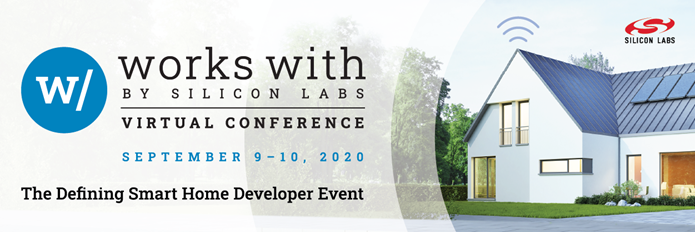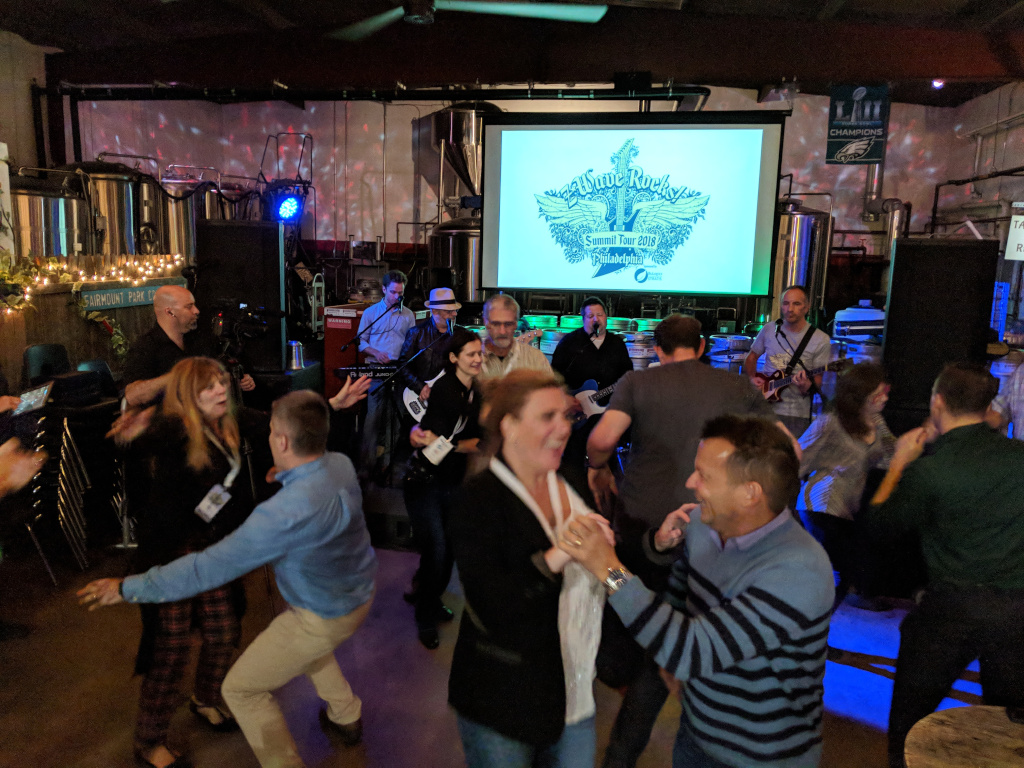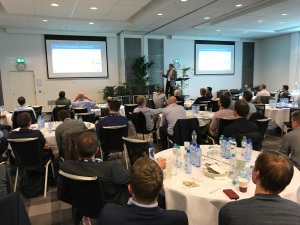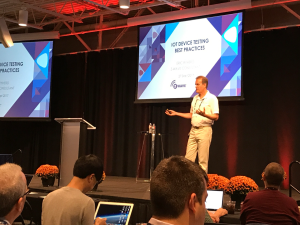
The Z-Wave Summit & UnPlugFest took place last week in Austin TX. If you missed it, here is a quick Recap. I organized the UnPlugFest on Tuesday which included an RF Range test down the Colorado River right in downtown Austin. The Z-Wave Alliance Reference Application Design (ZRAD) won the maximum range with a distance of 1.1miles (1.7km) which wasn’t quite line-of-sight (LOS). I produced a video of the event which you have to be a member of the Alliance to gain access. Virtually all of the other Z-Wave Long Range Devices tied in a close second place at 0.7mi (1.1km) however we had limited LOS points to test at bridges across the river. We proved that PCB antennas and shipping Z-Wave devices in a noisy RF environment can easily achieve over a kilometer of range. Note that we measured the range where we are getting 100% corruption free, fully encrypted packets at 100kbps. Obviously we could go much farther if we are just trying to get a NOP to ACK but that’s not useful even though other protocols use that as their yardstick.

The Open Source Work Group met in-person in the afternoon to work on finalizing User Code Command Class. Additional Range testing was measured inside the hotel (with concrete floors) where most devices were able to pass thru several floors. Late in the afternoon was the Fireside Chat where we aired our hope, desires and disappointments for Z-Wave. Watch for a survey coming out soon!
Tuesday evening is the network event which was hosted by Silicon Labs where all the Z-Wave personalities meet and renew friendships and business relationships.

My presentation on the Z-Wave Alliance (ZWA) Reference Application Design (ZRAD) is a preview of the soon to be released github project. There were lots of presentations on all sorts of IoT related topics. You can find the presentation on the ZWA members web site.
FUN! Electric Shuffle
After the UnPlugFest and a full day of presentations it was time to relax and join the competition at Electric Shuffle.

Summit Takeaways
This is my personal set of takeaways. Please add yours in the comments below!
- Z-Wave is very much alive!
- Lots of new products have been certified and more are in the pipeline
- Most are Z-Wave Long Range
- Z-Wave spec and Open Source Code continues to improve
- Z-Wave Long Range is indeed Long Range!
- Over 1mi LOS in downtown Austin – over 2mi proven in NH
- Certification for an SDK Update is Review ONLY!
- No need to redo the entire certification process to update the Z-Wave SDK
- Previously a full re-cert was required ($$$!)
- Now you can get the latest bug fixes/security patches and just file paperwork for cheap
- Can add Z-Wave Long Range (ZWLR) to a device and keep the same FCCID
- Can OTA devices already in the field to add ZWLR!
- Requires working with the “right” FCC test house and FCC must be redone with the new frequencies
- Talk to Trident for more details
- Why is the RF range so short in the EU for many devices?
- 500 series devices can only transmit at -1dBm (hardware limitation)
- 700/800 can transmit at +14! More than twice the range!
- Update those EU devices!
- USB Zniffer firmware can capture BOTH ZWLR frequencies
- Select US_LR_END_DEVICE for the region to get ONLY the 2 ZWLR channels (no mesh channels)
- Select US_LR_BACKUP to get the ZWLR B channel and mesh channels
- Select US_LR to get ZWLR A channel and mesh channels
- Z/IP Gateway has a maintenance release expected in June but there will probably only be 1 more maintenance release before it EOLs
- Switch to Unify or Z-Wave JS soon!











 back in 2001. My journey with Z-Wave began shortly after that in 2003 when I was disgusted with my highly unreliable X10 home automation experiments. I just couldn’t get that X10 junk to work! It was cheap, but it wasn’t worth my time and frustration so I was looking around for other technologies that would be reliable. I experimented with several custom baked wireless solutions but quickly realized that wireless is really hard and complicated. Z-Wave caught my eye because it was a real mesh network and actually worked. From there I have continued to be impressed by the technology improvements always with full backward compatibility and wide choice of fully interoperable products from many manufacturers.
back in 2001. My journey with Z-Wave began shortly after that in 2003 when I was disgusted with my highly unreliable X10 home automation experiments. I just couldn’t get that X10 junk to work! It was cheap, but it wasn’t worth my time and frustration so I was looking around for other technologies that would be reliable. I experimented with several custom baked wireless solutions but quickly realized that wireless is really hard and complicated. Z-Wave caught my eye because it was a real mesh network and actually worked. From there I have continued to be impressed by the technology improvements always with full backward compatibility and wide choice of fully interoperable products from many manufacturers. The Z-Wave team in Copenhagen resides in this modest building. Danes love to bicycle to work or take the excellent train/bus system. Only a few travel via car unlike those of us in the US who just love sitting in traffic for hours. The food in Copenhagen is wonderful with plenty of international choices as well as the Danish favorites. My hotel room is more of a spaceship pod than a boring room with the Danish penchant for efficient minimalism. The view of the windmills in the distance and the quaint classic European architecture are beautiful.
The Z-Wave team in Copenhagen resides in this modest building. Danes love to bicycle to work or take the excellent train/bus system. Only a few travel via car unlike those of us in the US who just love sitting in traffic for hours. The food in Copenhagen is wonderful with plenty of international choices as well as the Danish favorites. My hotel room is more of a spaceship pod than a boring room with the Danish penchant for efficient minimalism. The view of the windmills in the distance and the quaint classic European architecture are beautiful.

 I gave a presentation on Configuration Command Class Version 4 and all the wonderful things it can do. The most notable point is that 2/3rds of the Z-Wave Plus certified devices have at least one Configuration Parameter. Yet many hubs have no way of modifying or displaying to the user the current value of parameters. Z-Wave Plus V2 mandates support for Configuration Command Class V4 for both hubs and devices so you need to get busy! My presentation title is: “The Chicken vs Egg is over: Moving Your Product to Configuration Version 4” which can be downloaded from this link:
I gave a presentation on Configuration Command Class Version 4 and all the wonderful things it can do. The most notable point is that 2/3rds of the Z-Wave Plus certified devices have at least one Configuration Parameter. Yet many hubs have no way of modifying or displaying to the user the current value of parameters. Z-Wave Plus V2 mandates support for Configuration Command Class V4 for both hubs and devices so you need to get busy! My presentation title is: “The Chicken vs Egg is over: Moving Your Product to Configuration Version 4” which can be downloaded from this link: 
 IoT Device Testing Best Practices by Eric Ryherd
IoT Device Testing Best Practices by Eric Ryherd There were nearly 200 attendees at the Summit – a significant increase over last year. One of the main purposes of the summit is to learn what’s new in Z-Wave and what Silicon Labs is planning for the future. The most important news at this year’s summit is the 700 series which was
There were nearly 200 attendees at the Summit – a significant increase over last year. One of the main purposes of the summit is to learn what’s new in Z-Wave and what Silicon Labs is planning for the future. The most important news at this year’s summit is the 700 series which was  The Summit isn’t all work all day even though the days are long and filled with lots of technical information. This summit had an evening at the
The Summit isn’t all work all day even though the days are long and filled with lots of technical information. This summit had an evening at the 


 Click
Click  The presentation goes into detail on each of these topics so I won’t duplicate the information here. I also go thru several failures of devices I’ve been working with. You learn more from failures than you do when everything just works. Feel free to comment and let me know what topic you’d like to see for next years summit.
The presentation goes into detail on each of these topics so I won’t duplicate the information here. I also go thru several failures of devices I’ve been working with. You learn more from failures than you do when everything just works. Feel free to comment and let me know what topic you’d like to see for next years summit. The Summit isn’t all work all day though the days are long and tiring. Tuesday evening was a reception at
The Summit isn’t all work all day though the days are long and tiring. Tuesday evening was a reception at